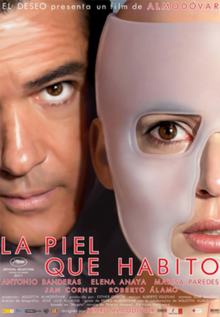Introducing Mireia Nicolas the first guest blogger to the Films blah blah blah world, hopefully she'll provide many more. A great review for a film I recently had a lot to say about in Small Films For Big Cinemas
La piel que habito / The skin I live in (Pedro Almodóvar, 2011)
Almodóvar has always been a love-him-or-hate-him kind of director, especially in his (and my) home country, Spain. I must admit that, even though I loved Volver with all my heart (he always manages to get the best out of Penélope Cruz) I was on the hate-him side. I always thought he gave an awful image of Spain – I was worried the irony in his colourful films, so outrageous and crazy and stereotypical, so evident for the Spanish audiences, would be lost on others and make them think Spaniards were actually like this, and quite frankly, in a world where people think Mexican hats are Spanish and that Spain is somewhere between Venezuela and Brazil, it was kind of thanks but no, thanks. Anyway, I am digressing.
One of my best friends found a job in Montreal and before leaving, he suggested we go see The skin I live in and for tapas (don’t judge us, we are Spanish). I was slightly wary, but I am not going to see my friend for a very, very long time so I accepted. Boy, were we in for a ride! The skin I live in can’t be described easily, nor can I talk about its plot freely. It tells the story of plastic surgeon Dr. Robert Lergard, (played by Banderas) who is obsessed with his mysterious patient Vera, (played by Elena Anaya). Vera/Anaya wears a full-body cat suit and spends her days doing yoga and creating art. She is secluded in a room in a big, beautiful estate near Toledo (Spain), where Banderas lives with his housekeeper, Marilia (played by Marisa Paredes, another constant actress in Almodóvar’s world) and the service. Soon we learn Lergard/Banderas has been experimenting with genetically modified human skin, in humans. The film goes back and forth in time, showing moments that explain us who Lergard, Vera and Marilia are.
Formally outstanding, the film offers some moments that are truly uncomfortable, so much that rumour has it during its premiere in Cannes some people started giggling nervously, the kind of giggle you can’t supress when you feel so awfully uncomfortable you either start giggling or just go away. The characters are tortured, crazy, deranged, their actions only comprehensible to them. The music is tortured, crazy, deranged – the soundtrack is excellent, sharp violins that go hand in hand with the images and keep the viewer on the edge of the seat. Banderas’ acting is outstanding, although his accent is a bit off at times, an Andalusian trying to speak in a normal Spanish accent – something anyway that only a very picky Spanish speaker like me would notice. However, it is not a film where he speaks a lot, a trait which is awfully unsettling – every time he is about to speak you worry he will do something terrible. Dr Ledgard is truly scary. Elena Anaya’s Vera is mysterious, alluring: her eyes tell a thousand stories in every single close up, her skin glows and glistens, her face wonderfully perfect, wonderfully crazy. She is the key to Bandera’s obsession, and it is only in the very end that we understand why. Marisa Paredes once again proves why she is one of the great actresses in the Spanish-speaking world, her character nurturing but at the same time unfriendly.
All in all, The skin I live in is an unsettling, impressive film that will leave you without words. Go and watch it. 8/10.
